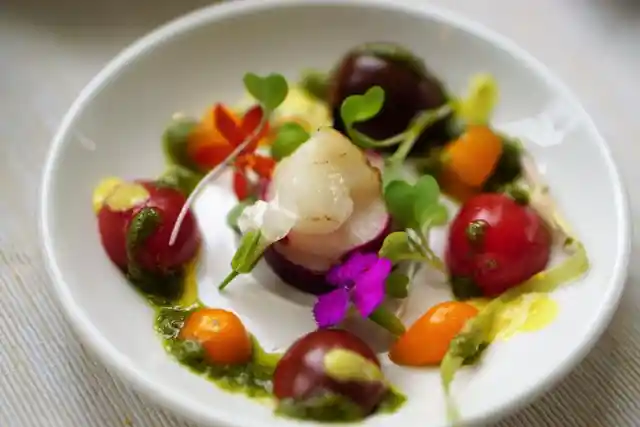The Magic Of Microgreens
You've probably seen these tiny greens, also known as microgreens, as garnishes on your plate or as a salad dressed in vinaigrette. But, aside from the apparent fact that they are incredibly small, what precisely are microgreens?


What are microgreens? Microgreens are seen as functional food or as many call them a superfood. Microgreens, like sprouts, are young vegetables. But sprouts and microgreens are not the same things. Sprouts are newly germinated seeds harvested just as they begin to grow and before their leaves appear. Microgreens, on the other hand, are sprouts with leaves. Their color and delicacy make them an easy option in terms of aesthetic appeal, adding that much-needed pop to recipes. But, despite their small size, these lovely little morsels are packed with nutrition.
Reasons behind their Popularity Taste: They add a surprising amount of flavor and texture to a meal. A fistful of microgreens can give color, volume, and flavor to even the most basic of recipes. It is entirely dependent on the plant as to how they taste. What they taste like varies entirely on the plant. Nutrients in Concentrated Form: Microgreens are 40 times richer in nutrients including vitamins C, E, and K, lutein, and beta-carotene than mature leaves of the same plants. Microgreens have varying quantities of these nutrients, much like their full-grown counterparts. Of course, grown veggies can never be replaced since they provide the fiber that your body requires, but microgreens can fill in all of the other gaps in your diet. Easy to Grow and Sustainable: As there is a rising interest in sustainability microgreens might be a fantastic way to give city dwellers locally grown seasonal veggies at a reasonable cost. Microgreens are simple to grow in a small space at home. A tiny investment may provide a big payoff in terms of volume, diversity, and nutrition. It is feasible to have an ongoing supply of microgreens. They're also low-maintenance and ready to harvest in days, so you don't need a green thumb or a lot of patience to grow them.
What's the catch, then? Microgreens can be expensive and difficult to come by. Depending on the type, a flat of microgreens might cost up to $30. It's surely not the most affordable food on the planet. Furthermore, despite their increased popularity, certain types are not available. But then again, as we have mentioned already, they can be easily grown in the comfort of your home.
How to grow your own flat of microgreens? Growing microgreens does not require much besides the seeds and most of the tools can be found at home or in any household product store. All you need are seeds of the microgreens you want to grow, some containers, and small tools. Clear fruit or salad boxes, as well as plastic take-out dishes and disposable pie plates, work well. If the container you've picked doesn't have drainage built-in, make a few drainage holes at the bottom. Step by step to growing your microgreens:
- Fill the container with an inch or two of damp potting soil or mix. Flatten and level it with your hand or a little piece of cardboard, being careful not to over-compact the soil.
- Evenly scatter seeds on top of the soil. Using your hand or the cardboard, carefully press it into the earth.
- Cover the seeds with soil and spray with water. The soil layer shouldn’t be thick. You may skip this step if you like and instead cover the container with a transparent lid or plastic wrap until the seeds sprout.
- While you wait for sprouts to grow, which normally takes three to seven days, spray the soil once or twice daily to keep it moist but not soggy.
- Once the seeds have sprouted, remove the cover (if you used one) and sprinkle once or twice daily.
- Microgreens require four hours of direct sunshine every day to flourish. It can vary with seasons, a little more in winters.
Which seeds are best for growing microgreens? Here are some of the seeds you can use for microgreens: 1. Radish: High in vitamin E, K, and C 2. Kohlrabi: High in antioxidants, fiber, vitamins A, C, and B-complex, calcium, potassium, and copper 3. Collards: High in vitamin K 4. Pea: High in vitamin C and folic acid 5. Kale: high in antioxidants 6. Clover: High in calcium, iron, magnesium, and zinc 7. Beet: Rich in antioxidants and vitamins A and K 8. Buckwheat: Has anti-inflammatory compounds 9. Alfalfa: Reduces cholesterol 10. Mustard: High in vitamin C, E, and K, calcium, potassium, antioxidants 11. Broccoli: Rich in vitamin A, C, and E
How to use microgreens in your dish? Microgreens are adaptable and easy to experiment with. They may be used as a fresh garnish on almost any savory dish, including soup, pasta, grain bowls, stir-fries, avocado toast, eggs, baked potatoes, casseroles, roasted vegetables, and pork, or fish. It can be tossed in a salad, put on a pizza, or blended together with fruits for a smoothie.